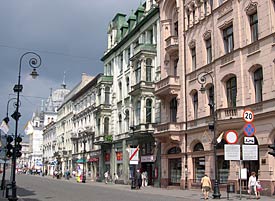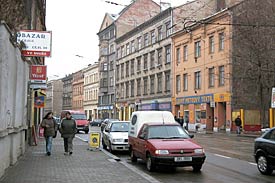Press release April 25, 2008
Shrinkage and ageing are Europe-wide challenges
Scientists discuss the impacts of demographic change on European cities
Leipzig. Unlike in Eastern Germany, shrinking numbers of city dwellers in the Czech Republic and Poland did not so far lead to massive numbers of unoccupied properties and demolitions. In East Central Europe, there are other reasons for the presence of empty apartments, e. g. the bad state of repair. These are the findings of a research project conducted by the Helmholtz Centre for Environmental Research (UFZ), which compares population development in the cities of Brno and Ostrava in the Czech Republic and Gdańsk and Łódź in Poland with Leipzig in Eastern Germany. The researchers found that empty properties in Poland and the Czech Republic were not the result of an oversupply of housing, but rather the result of a real need for redevelopment in districts with old building stock. Since many tenants are not registered or flats are illegally sublet, the official statistics often do not reflect the reality, according to the researchers. At the same time, however, there are some parallels with Germany. Most importantly, the ageing population needs to be mentioned.

Łódź in Poland lost more than 81.000 inhabitants since the fall of Communism in Eastern Europe. This is more than one in ten inhabitants.
Source: Annegret Haase/UFZ

Brno in the Czech Republik lost about seven percent of its inhabitants since 1989.
Source: Annegret Haase/UFZ

Ostrava near the Polish border is an old centre of the coal and steel industry.
Source: Annegret Haase/UFZ
From 14 to 16 April, 130 scientists from 15 countries were discussing the impacts of demographic change on European cities at an international conference at the UFZ in Leipzig. Population developments always have impacts on the environment: empty apartments are heated alongside occupied ones, plots of land are not desealed after a demolition. Public transport becomes less efficient in a city with declining residential density. Therefore, declining populations not necessarily result in less environmental impact.
Łódź has lost more than 81,000 inhabitants since the fall of Communism in Eastern Europe. That is more than one in ten inhabitants for this Polish city. In comparable Czech cities the situation is not that grave but also there the number of inhabitants decreased for quite some years in the 1990s. Ostrava and Brno, for example, have each lost seven per cent of their inhabitants. But there are also some causes that vary widely from one country to another. Whereas in the Polish cities the population is moving to the capital or abroad, Czech city-dwellers tend to move to privately owned homes in the suburbs. This ‘suburbanisation’ is playing a major role in the Czech Republic, as it did in Eastern Germany in the 1990s. It is less significant in Poland, however. The population decreases are just the beginning: since the birth rates in the formerly socialist countries of Eastern Europe are among the lowest in the world, the forecasts are alarming. Poland’s Central Statistical Office estimates that populations in the larger cities alone will fall by between 20 and 30 per cent by 2030.
Changes are taking place in the inner cities as well: in all four of the cities studied the inner-city residential areas have seen significant population decreases between the 1991 and 2001 censuses, as well as already in the decades before. Whereas the total population in Łódź fell by around 10 per cent, the decline in the inner city was as high as 20 per cent, according to official statistics. However, the social scientists believe that these figures should be treated with caution, since inner cities often attract younger people who do not register with the authorities or live as subtenants on a black rental market. In Brno for instance, according to the census the inner-city population supposedly has a higher average age than that of the city as a whole. “But our qualitative studies in Brno showed a significant reduction in the average age of the inner-city population, which was often not reflected in the local register or in the censuses,” the researchers write in their interim report.
However, a general trend can be observed in Poland and the Czech Republic: the number of one-person households is increasing. They now account for between 30 and 35 per cent, and for as many as 40 per cent of households in the inner cities. The proportion of single parents has also increased. By contrast, the proportion of households with more than three people, i.e. the classic family, has fallen steeply since 1990.
After 1989, state-owned housing stock in Poland and the Czech Republic was transferred to the local authorities and gradually privatised. Unlike the prefabricated concrete constructions of the post-war era, however, large numbers of old apartment buildings in the inner cities still belong to the local authorities and are viewed by their long-term tenants, many of whom are living alone in large flats, almost as their own property. By contrast, young families are often unable to find suitable housing, which aggravates the housing shortage. In addition, all four of the cities studied have up-and-coming areas with high-income inhabitants and areas with concentrations of low-income inhabitants.
Demographic change and its consequences for urban development are a Europe-wide phenomenon. In the long term, this phenomenon will have similar consequences for housing market demand and infrastructure utilisation in East Central Europe to those currently being observed in other parts of Europe. The problems facing Eastern Germany today therefore sound a warning for Poland and the Czech Republic over the coming decades, where similar developments are expected in places. Cities need to provide quality of live to an ever ageing, in some places declining population. The experiences made in East Germany might be of interest to our neighbours. At the same time, however, local authorities in Eastern Germany have something to learn from their eastern neighbours. For instance, the greater autonomy enjoyed by the districts in Czech cities is having a positive impact on their development.
The research project ‘Social and spatial consequences of demographic change in East Central European cities’ is part of the funding
initiative ‘Unity amidst variety? Intellectual foundations and requirements for an enlarged Europe’ of the Volkswagen Foundation. Using
Czech and Polish cities as a basis, the project will study which experiences from the new states of Eastern Germany are transferable and
where there are national differences. The Helmholtz Centre for Environmental Research in Leipzig-Halle (UFZ) is working closely with the
Czech and Polish Academy of Sciences, the University of Gdansk and the University of London.
Tilo Arnhold
More information:
Dr. Annegret Haase, Dr. Annett Steinführer, Dr. Katrin Großmann
Helmholtz Centre for Environmental Research - UFZ
phone +49 341-235-1735, -1736
Dr. Annegret Haase
Dr. Annett Steinführer
Dr. Katrin Großmann
oder über
Helmholtz Centre for Environmental Research - UFZ
Press office
Tilo Arnhold / Doris Böhme
Telefon: +49 341 235 2278
presse@ufz.de
Publication
Annegret Haase, Katrin Großmann, Sigrun Kabisch, Annett Steinführer:
Städte im demographischen Wandel – Perspektivenwechsel für Osteuopa.
OSTEUROPA , 58. Jg., 1/2008, S. 77-90.
Städte im demographischen Wandel
Links
International Conference
"Socio-demographic change of European cities and its spatial consequences"
Conference site: Socio-demographic change of European cities
At the Helmholtz Centre for Environmental Research (UFZ) scientists research the causes and consequences of far-reaching environmental changes. They study water resources, biological diversity, the consequences of climate change and adaptation possibilities, environmental and biotechnologies, bio energy, the behaviour of chemicals in the environment and their effect on health, as well as modelling and social science issues. Their guiding research principle is supporting the sustainable use of natural resources and helping to secure these basic requirements of life over the long term under the influence of global change. The UFZ employs 900 people at its sites in Leipzig, Halle and Magdeburg. It is funded by the German government and by the states of Saxony and Saxony-Anhalt.
The Helmholtz Association contributes to solving major challenges facing society, science and the economy with top scientific achievements in six research areas: Energy, Earth and Environment, Health, Key Technologies, Structure of Matter, Transport and Space. With 25,700 employees in 15 research centres and an annual budget of approximately 2.3 billion euro, the Helmholtz Association is Germany's largest scientific organisation. Its work follows in the tradition of the great natural scientist Hermann von Helmholtz (1821-1894).
